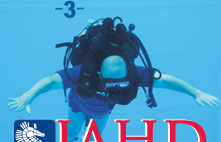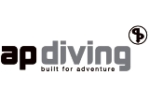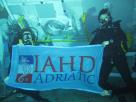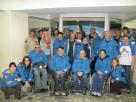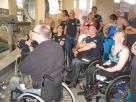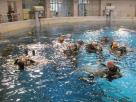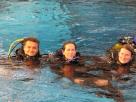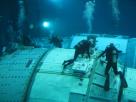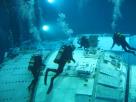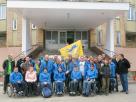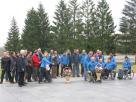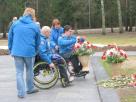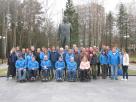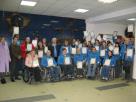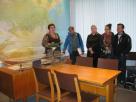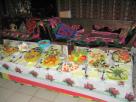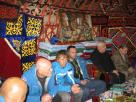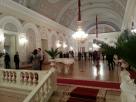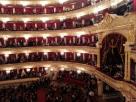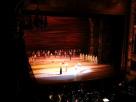NEWS & MOVIES ARCHIVE
Moscow and Star city
Our fairy tale started already a year or two back, when Branko mentioned that one of our future goals is to visit the Star City and to dive in the Hydrolab, which serves as a training centre for Russian cosmonaut and where they practise walking in the universe and working on the space station. In March we received the confirmation from the Star City and so the preparations begun...
On Friday, 26th of April 2013, we all gathered at the Joze Pucnik airport, boarded a plane A319 and started our journey toward Moscow. In Moscow we were greeted by Sergey Kovalev and Svetlana Murashkina, who took care of us the whole time of our stay and provided us with a whole bunch of interesting facts about Russia and above all about the city of Moscow.
When we arrived at the Moscow Home Hostel, we had a bad first impression since we were greeted by a really neglected lobby (a huge amount of dust, falling plaster, rusty railing) and there was also some improvisation needed about our installation. Despite the fact that not everything was ideal, we felt there as at home. During our stay, the lobby was completely renovated, so consequently our hands were most of the time painted with fresh paint.
We continued our journey with a walk to the restaurants. We have previously noticed that Moscow is a huge city. Columns of cars that are passing in all directions (surprisingly there are almost no Russian cars among them) make the roads unbearably crowded practically at all time. Architectural styles constantly change at every step, but unfortunately we too soon realised, that travelling the streets in the wheelchair can be a real nightmare. The city is completely unadapted and most of the shops and restaurants have high thresholds or stairs and if you want to cross any major road, it is necessary to use underpasses that have many stairs and are impassable without helping escort. Consequently our team was provided not only with amazing sights and tons of information, but also with free four day fitness training.
Since our timetable was packed all the time, it was necessary to keep up with the schedule. Therefore we used our bus transport from one venue to another to explore different parts of city (all buses were equipped with lifts). On Saturday we attended at first the Russian version of the fair REHA CARE (Integration.Life.Society), where equipment for disabled persons was presented as well as a wide range of activities, which may be attended by all people, no matter what their disability is. Also having their own stand were our friends from diving club AQUA GLOBUS from Anapa, which attracted many visitors of the fair. The fair was also attended by Slovenian Ambassador Mrs. Ada Filip-Slivnik and together we took part in a roundtable discussion on the theme Way to paradiving where we presented our work over the past years and the possibility of passing our knowledge to future Russian paradivers.
We used the afternoon for a small shopping trip to the market, a sort of a flea market, where they sell everything you can imagine. The most sought-after goods were of course the babushkas. The choice was really big.
In the evening, the biggest part of our team went to the famous Bolshoi Theatre where we were able to see the Spartacus ballet. The Bolshoi Theatre has been completely renovated recently and is already as a building itself a real eye-catcher. At the sight of the main hall we were left without words, however we were equally impressed by other parts of the theatre which we were able to see during the breaks.
I have never before watched a ballet performance, so I didn´t know what to expect. The dancers were excellent, and I knew the story line, so at the end I admired the performance on stage with open mouth for almost three hours. This time the wheelchair represented an advantage, since it enabled me to admire the performance from the parterre. The fact that shows the quality of the performances is that they are all sold out and that the ticket prices go up in the sky.
Despite the late hour our day was after Bolshoi Theatre not finished. We used the ride with Metro to our hostel to visit some stations. First Metro stations were built after 1935. The speciality of the Metro is its stations, because all 186 stations differ and are unique. However, in order to reach them it is necessary to descend by escalators, which are incredibly steep and fast. Some stations are more than 100 meters underground. The Metro is the fastest and the main way to travel in Moscow and it is used on a daily basis by up to 6 million people. In the rush hours trains depart station in every 40 seconds.
Soon it was already Sunday, our day D when we visited Star City. Our new bus driver got already lost on his way to our hostel, however we reached our highly anticipated goal with a minor delay. Star City is completely closed to outer visitors. The population of the city is represented by those who work in any part of the city and their families. At our arrival we were greeted by the head instructor of diving for the Russian cosmonauts, Valery Nesmeyanov, who also guided us later through the part of the city and dived with us in the Hydrolab. The speciality of the pool is that it is filled with distilled water, which can most closely approximate the feeling of the weightlessness in space. For our visit two modules from the space station Mir were sunk into the pool. One is already installed in the universe and the other one will make its journey this autumn. The outside of both modules is completely identical to those in the space, because here the cosmonauts train walking in space and working outside of the space station. We dived along with the Russian paradivers and looked closely at every part of both modules. For the first time in the history such dive was made by handicapped divers. The dive was a complete success and brought a new dimension to all of our lives.
We just had time to take some memory photos and then our visit continued in hangar with space simulators that are inside identical to shuttles that take cosmonauts to the space. In them the future cosmonauts daily perform their training. In the day after our visit an important test was taking place in exactly those simulators. Education and training of the cosmonauts usualy takes five years. In addition to technical training, it also requires excellent physical fitness and survival training in the most extreme conditions.
After that we took a walk to the monument of Yuri Gagarin, the first man in space, where we were accepted by the Mayor of the Star City Nikolai Nikolajevich Rybkin and Chief of Russian cosmonauts, Sergei Aleksandrovich Volkov, who has also been member of space expedition for three times. Together we laid flowers in front of the monument. Then we went further up to the museum dedicated to Yuri Gagarin and learned many interesting things about his life and about the equipment of the first space expeditions. We also visited his office, where he worked until his tragic death, when he was killed during the testing of the new aircraft. Later, the Mayor awarded all divers with special diplomas that proove our ability to dive in the hydrolab.
After a busy day we really enjoyed a little relaxation when our hosts prepared us traditional dinner in Mongolian tent »jurta«, where they served us Russian cuisine. They presented us some national costumes which we were also able to try on.
As it goes for this day I can only say that we have seen and experienced much more of our greatest expectations. We were excepted very kindly and were treated practically as a State visit and we felt very welcomed. We experienced a really amazing thing.
On Monday we continued our visit with another tour of the Kremlin and the Red square. Kremlin is the home of Russian authorities, however it has also a number of museums and churches. Although the representatives of the authorities do not live in Kremlin, they have here their offices and it is here where all the meetings of the highest level take place. Kremlin was originally the fortress around which the city was build and can be found in many Russian cities. It represented a place where people were able to hide in a time of a danger. Nowadays Kremlin shows its tremendous wealth outwardly as well as inwardly. Here are many gold-domed Orthodox churches with exceptional interior, where many Russian emperors were cronated. Some of them are here also buried. Here it is displayed huge 40 tones heavy cannon, which never worked, and a 200 tones heavy bell, which unfortunately broke due to an error in manufacture and therefore never rang. A real show off is Russian Treasury of gold and diamonds. Security measures for the entry are extremely strict and inside you can just watch and wonder. Here there is on display the largest golden stone ever found (has 37 kg), here are the unbeatable diamonds and precious stones. Some are exhibited individually, while others are embedded in the jewelry, which is a real eye-catcher. One of the crowns has built in it more than 1,700 small diamonds. Inside of the two little rooms is exhibited a truly amazing wealth.
Full of impressions we moved further on to the Red square. Here is the Lenin mausoleum, which was still closed due to renovations. Also buried here are the representatives of the newer Russian authorities. It is tradition that the Russians show here at an annual military parade their military power and at the time of our visit the whole square was being prepared for the parade. Kremlin and the Red square are the symbols of Russia in the world.
During our visit to Moscow we were acepted by by the Ambassador of Slovenia Ada Filip-Slivnik and Ambasador of Croatia Igor Pokaz, and we were able to taste a part of our motherland (walnut cake, prosciutto) even far away from our homes.
Expedition to Moscow and the Star City at the end exceeded all of our expectations. Thank you to everyone who made us feel at home and welcomed, thank you to all who had take care of the organisation and at the end, thanks to our escorts for all your help.
Ales Povse – Yoda
Translation: Katarina Richter
Foto: Nevenka R. Pece, Katarina Richter
30. 04. 2013
Production & design: Creativ, Novi mediji d.o.o.
